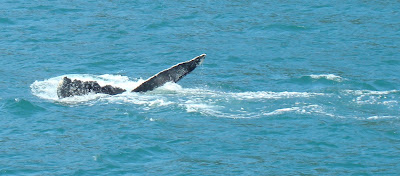
"The humpback whale (Megaptera novaeangliae) is a species of baleen whale. One of the larger rorqual species, adults range in length from 12–16 metres (39–52 ft) and weigh approximately 36,000 kilograms (79,000 lb). The humpback has a distinctive body shape, with unusually long pectoral fins and a knobbly head. It is an acrobatic animal, often breaching and slapping the water." When you look at the photographs you lose perspective of how large the creatures really are. The diagram above gives you the size of the animals in these photographs. So when you see a fin, a tail ,hump, or blow spout refer back to the drawing to see how those compare to the whole animal.
We left junior on the MS Amsterdam as we took a Holland American excursion out to look for the humpback whale. He had a good view and several salmon were jumping in the water so he was well entertained.

We took a jet powered catamaran out to Akue Bay.
We passed one of the Alaskan Marine Highway's ferries on our way out. These ferries crisscross SE Alaska providing access to its otherwise isolated towns and cities.
The shores in this region drop off into steep and deep canyons carved by glaciers long ago. So Whales can come very close inshore. These sport fishermen seem oblivious to the humpback feeding close to them.
In fact as we watched we couldn't help but wonder if they both might be after the same fish.

Our objective was to find humpbacks bubble net feeding in the bay.
"The humpback has the most diverse feeding repertoire of all baleen whales. Its most inventive technique is known as bubble net feeding: a group of whales swims in a shrinking circle blowing bubbles below a school of prey. The shrinking ring of bubbles encircles the school and confines it in an ever-smaller cylinder. This ring can begin at up to 30 metres (98 ft) in diameter and involve the cooperation of a dozen animals. Using a crittercam attached to a whale's back it was discovered that some whales blow the bubbles, some dive deeper to drive fish toward the surface, and others herd prey into the net by vocalizing. The whales then suddenly swim upward through the 'net', mouths agape, swallowing thousands of fish in one gulp. Plated grooves in the whale's mouth allow the creature to easily drain all the water that was initially taken in. Solitary humpbacks have also been observed employing this technique"
"The humpback is an energetic hunter, taking krill and small schooling fish, such as herring(Clupea harengus), salmon (Salmo salar), capelin (Mallotus villosus) and sand lance (Ammodytes americanus) as well asmackerel (Scomber scombrus), pollock (Pollachius virens) andhaddock (Melanogrammus aeglefinus) in the North Atlantic. Krill and copepods have been recorded from Australian and Antarctic waters. Humpbacks hunt by direct attack or by stunning prey by hitting the water with pectoral fins or flukes."
We were aboard a vessel from the Allen Marine Tours, Juneau that was arranged through Holland America.
We were very lucky on this excursion. We were able to observe at least three different pods of humpbacks bubble net feeding several times each.
We watched this one pod bubble net three times virtually in some guys front yard. (enlarge the photo and see the home on the shore)

That humpback whales use bubble net feeding was a relatively recent discovery. "In 1979, a high school teacher in Juneau, named Charles Jurasz, was the first to observe and write about humpback whales using a cooperative feeding technique with complex bubble blowing. He called the technique 'bubble net feeding." The aerial photo above shows the technique.
This guy was courting.
The next series of photos are of a single pod of 16 whales bubble feeding.
Where there are whales feeding there will be birds looking for a meal of there own.
It was a very very good day.




















4 comments:
Joe, these photographs along with the narrative are exceptional. So heppy that you and Jeanne are enjoying life. You both deserve sunshine and happy days. Thanks for sharing the gifts of lives well lived.Gina
How big are these guys really ? check out this National Geographic clip: http://www.youtube.com/watch?v=K0_h3AAn7Pk&feature=related
that reminds me, i need to dvr whale wars
I am very fortunate in that I am able to return to the Inside Passage and Alaska again this July and August. I have reservations for a small catamaran to tour the Tracy Arm for Humpback, Orca, bear, mountain sheep,
seals,and a couple of glaciers up close and personal.
Post a Comment